Inside Ocelot
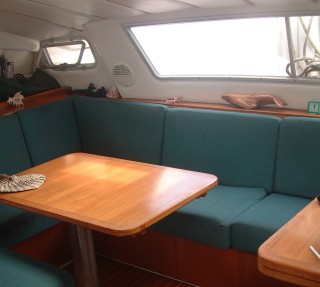
Settee and inside dining area from the nav-station |
Inside the Salon: (see photo at right)
The 2 salon tables unfold and come together, providing ample dining
area for 8 to 10 people.
We like the rectangular shape of the settee, which gives us some nice lounging areas.
Lots of modern French boats have really rounded settees – tough on the spine
when you try to put your feet up! Visibility outside is superb with the big
main window forward (the long window in the picture) and big, louvered windows
on each side (not shown in this photo, but visible in several other
photos on this page). There are 3 overhead opening hatches
for ample ventilation (important in the tropics)
as well as the two smaller hatches on either side forward (one shown open in
the upper left). All lighting is by very efficient 12v halogen
lights, recessed into the headliner. We replaced the original blue cushions
in Venezuela with a firmer foam and textured blue-green Sunbrella fabric
shown to the right. The head-liner is an easy-to-clean padded vinyl,
with teak-strip accents. There's lots of storage space under
and behind the settee. |
The Navigation Desk
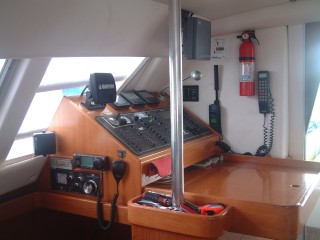
The Nav table set-up with radar, instruments, AC/DC circuit
panel, radios, satellite phone, etc., and, of course, chart storage. |
The photo to the right shows the Nav-desk, which is just to the
right as you enter the salon from the cockpit (the companionway can just
be seen to the right of the photo). The Ham/SSB radio, antenna
tuner, Pactor (email) modem, mic and speaker are all on the closest
wall, facing the camera. The big black panel is the massive AC/DC
circuit breaker panel. This is hinged for easy access to the
wiring behind it. Above that is the new Garmin GPS and repeaters
for the wind-speed and direction, GPS, and Tri-data sailing instruments.
The radar is hanging from the head-liner (just to the right of the pole in
the picture).
The tabletop lifts up to store
the working charts and other navigational books and small tools.
There is additional storage under the nav-desk
On the bulkhead to the right of the fire extinguisher is our backup VHF
radio, but we usually use our newer Standard Horizon (mounted closer to the helm
to the right of the picture). The black rectangle on the wall is our Heart
Interface, where we turn on the big inverter, and the white one near the
head-liner is the solar panel charge controller and battery
voltage display. Our Iridium phone with its strange antenna
nestles neatly against the bulkhead ready to receive messages. The long arm to
the left of the phone is the night-light.
|
Jon on the radio, en route to Tonga, May 2004
In the Galapagos (of all places) we had the Single Side Band / Ham radio
gear built into the side of the electrical panel. For you radio geeks,
our radio is an Icom 706 Mark II/g,
an extremely compact and capable transceiver. In ideal conditions it can reach around
the world and it can transmit and receive on just about any frequency from 0.5
to 500 MHz. This is coupled to a 300 watt MFJ-969 antenna tuner, which
comes with a nice roller inductor and cross needle meter to measure both
forward and reflected power. The antenna itself is just a long wire
that extends from the side of the boat up to our uppermost spreader. Also
now hidden behind the electrical panel is our SCS-PTC/2e
modem that connects the radio to the computers. With it we can
send and receive e-mail
as well as weather-fax images (and a whole lot more we
haven't tried yet). The electrical circuit-breaker panel hinges
forward for easy access to the wires behind, and the vinyl headliner comes off
very easily for re-wiring activities. |
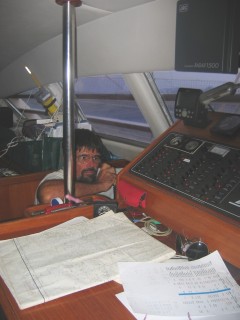 |
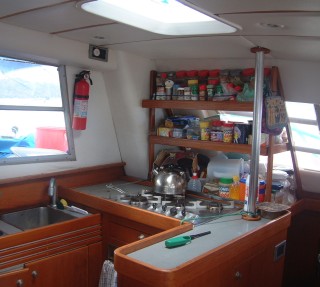 |
In the Galley:
Just to port as you come in the companionway is the nice, compact galley.
The 4-burner stove has an oven underneath.
We have replaced the front opening fridge with a custom top opening, electric
fridge/freezer. We
like the size and the window aft to the cockpit. This makes a great
pass-through when the party's in the cockpit. It may look small, but
it has more space, features, and storage than our galley did on
Oriental Lady.
We called that home for 7 years and regularly prepared meals for 4 to
8 people. On Ocelot we often prepare and serve meals for 10-12
people (I think our maximum so far is 20)!In Venezuela we added the shelves
behind the stove-top. The galley comes with a fresh-water foot-pump in
addition to the hot and cold pressure water system. |
| Two (old) views of the galley, navigation station and the sliding
door to the cockpit. The older one, on the left, shows the corner
of the original front-opening fridge (black outline). This has now been
replaced
with a top-opening electric fridge/freezer with 4-6 inches (10-15cm) of insulation
(far right). OK, you can't see much except that the old
fridge is gone and vegetables are now hanging in their small hammocks
from the top shelf. The old fridge door got replaced with
varnished teak to match the rest of the wood, and the new fridge door
uses recessed handles and is cut out of the old countertop so it blends
in nicely. |
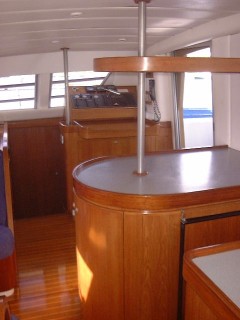 |
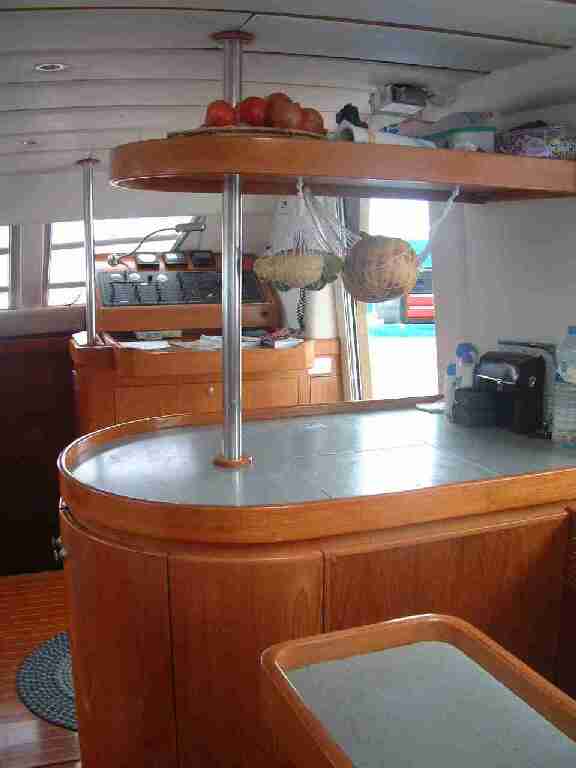 |
In the Cabins:
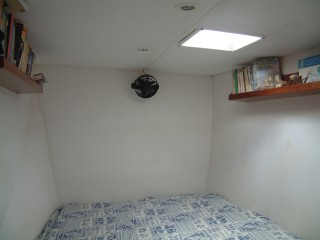
All 4 cabins now have at least 2 varnished teak
bookshelves. Here's the starboard forward cabin
with its fan, hatch, and bookshelves. |
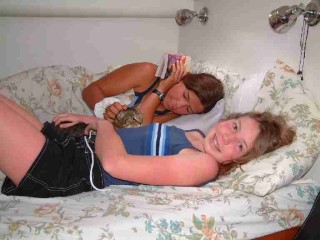
Pre-bookshelf photo of Arthur (the cat), friend Daryl,
and Amanda on her athwart-ship aft cabin bunk.
Each cabin has reading spotlights as well as area lights. |
Down in the hulls are 4 staterooms, 1 in each corner of Ocelot, each
with its own head, dressing
space, and storage lockers. The heads each have a sink, shower, toilet,
and a cabinet behind a mirror, as well as a hatch and a porthole. Each
stateroom has a hatch over the bunk and another over the dressing area,
plus a side porthole, so the ventilation is good in anything but a rain
squall. The forward cabins have double beds in the hulls (fore/aft) while
the aft cabins have athwart-ship double beds. Amanda's aft
cabin always has space for friends to sleep over! Each cabin now also has
at least 2 varnished teak book-shelves, built and finished (very nicely) by the kids as
a school wood-shop project. The fan in each cabin provides ample
ventilation on those Fijian summer nights when there is no breeze.
Up | Ocelot Layout | Ocelot's Deck | Cockpit Photos | Inside Ocelot | Kronos 45 Specs | Modifications | Refrigeration | Venezuela Haul Out | Tonga Haul Out | Thai Refit
Top Level:
Home |
Destinations |
Cruising Info |
Underwater |
Boat Guests |
Ocelot |
Sue |
Jon |
Amanda |
Chris |
Site Map |
Make a Comment
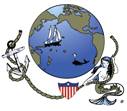 |
Lifetime
Commodores
of the
Seven Seas
Cruising
Association |
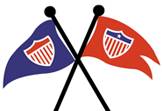 |
|
If our information is useful,
you can help by making a donation
|
Copyright © 2000‑ Contact:
Jon and Sue Hacking -- HackingFamily.com, svOcelot.com.
All rights reserved.









